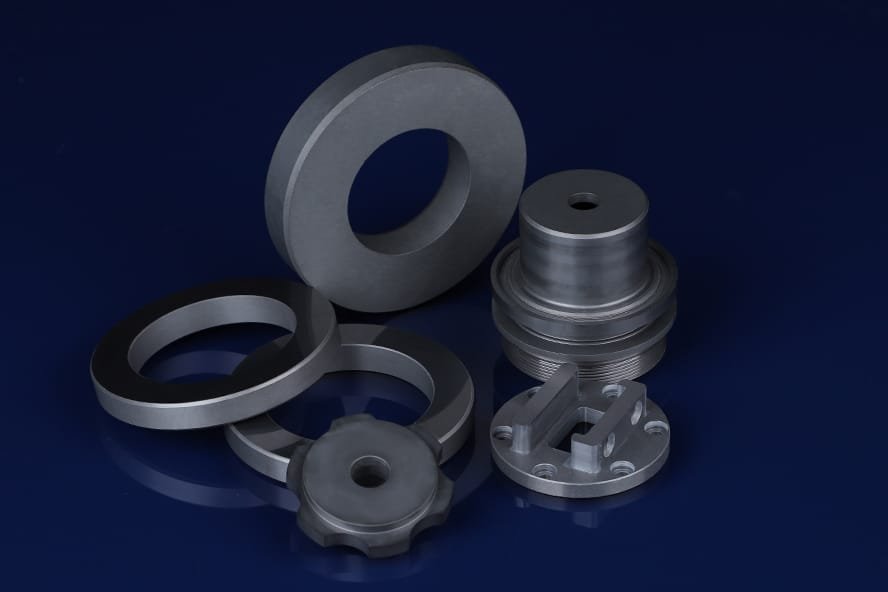Silicon Carbide(SiC/SiSiC)
Silicon carbide (SiC) is one of the hardest ceramic materials, just after diamond. It stands out for its excellent wear resistance and heat dissipation, making it ideal for use in a wide range of industries, from electronics and automotive to aerospace and industrial machinery. SiC remains stable across a broad temperature range and resists thermal deformation, which adds to its reliability in tough conditions. It also boasts low thermal expansion, great thermal conductivity, and impressive resistance to acids and alkalis. The two main types, SSiC (sintered silicon carbide) and SiSiC (silicon infiltrated silicon carbide), are especially suited for producing large, complex components, offering outstanding performance where durability and precision are essential.

(SiC/SiSiC) Advantages
- Good gliding properties
- Non-toxic and environmentally safe
- Hardness second only to diamond
- Excellent high-temperature resistance
- High Young’s modulus (380 to 430 GPa)
- Excellent thermal shock resistance (ΔT = 1,100 K)
- Corrosion and wear resistant even at high temperatures
- Maintains high strength under both high and low temperature conditions
(SiC/SiSiC) Applications
- High-temperature and high-voltage power semiconductor devices
- Wear-resistant mechanical seals
- Heat exchangers
- High-temperature sensors
- Optical reflectors
- SiC ceramic bearings
- Energy technology components
- Pipeline system components
- Refractory linings for high-temperature environments
Material Properties
| Property | Unit | Silicon Carbide |
| Density | g/cm³ | 3.15 |
| Vickers Hardness | Hv0.5 | 2650 |
| Bending Strength | MPa | 450 |
| Compressive Strength | MPa | 2650 |
| Elastic Modulus | GPa | 430 |
| Toughness | MPa·m¹/² | 4 |
| Poisson’s Ratio | – | 0.14 |
| Young’s Modulus | GPa | 430 |
| Purity of Silicon Carbide | % | 99 |
Thermal Properties
| Property | Unit | Silicon Carbide |
| Thermal Conductivity @ 25°C | W/mK | 110 |
| Melting Point | °C | 2800 |
| Specific Heat Capacity | J/gK | 0.8 |
| Linear Expansion Coefficient | 10⁻⁶/K | 4 |
Electrical Properties
| Property | Unit | Silicon Carbide |
| Dielectric Constant (1 MHz) | – | 10 |
| Breakdown Voltage | V/cm | 1×10⁶ |
| Dielectric Loss (1 MHz) | – | 0.001 |
| Resistivity | Ω·cm | 10⁷–10⁹ |
Note: This value is for reference only and may vary slightly depending on the batch conditions.
Silicon Carbide Machining
Silicon carbide (SiC) machining is a challenging yet essential process for producing high-performance components used in extreme environments. Known for its exceptional hardness, high thermal conductivity, and wear resistance, SiC is commonly used in industries such as aerospace, automotive, electronics, and energy. Machining SiC requires specialized tools and techniques, as the material’s hardness and brittleness make it difficult to cut and shape using traditional methods. Precision grinding, diamond tooling, and laser machining are often employed to achieve the desired dimensions and surface finishes. Advanced techniques like waterjet cutting and ultrasonic machining can also be used for complex geometries. Proper machining of silicon carbide ensures the production of durable, high-quality parts that maintain stability in high-temperature, high-pressure, and chemically aggressive environments.
Prototype Machining Video
This is a ceramic prototype machining video from Jundro
Frequently Asked Questions
What is Silicon Carbide (SiC) and why is it used?
Silicon Carbide (SiC) is a highly durable, heat-resistant ceramic material with excellent thermal conductivity, mechanical strength, and electrical properties. It is widely used in high-performance applications such as power electronics, automotive, aerospace, and semiconductor industries.
Why is silicon carbide used in semiconductor applications?
Silicon carbide offers high thermal conductivity, wide bandgap, and excellent chemical stability, making it ideal for high-power, high-frequency, and high-temperature semiconductor devices.
How does Silicon Carbide compare to traditional materials like silicon or ceramic?
Silicon Carbide outperforms traditional silicon and many ceramics in high-temperature, high-power, and high-voltage environments. It has superior thermal conductivity, higher breakdown voltage, and greater durability, which make it the material of choice for demanding applications such as power switching, electric vehicles, and renewable energy systems.
What types of SiC parts are commonly used in the semiconductor industry?
Typical parts include wafers, substrates, fixtures, susceptors, rings, and precision mechanical components used in CVD, PVD, and etching processes.
Is Silicon Carbide a good material for high-temperature applications?
Yes, Silicon Carbide excels in high-temperature environments. With a high melting point (around 2,700°C), it can operate at temperatures where traditional materials would fail, making it suitable for high-temperature applications in industries like aerospace, defense, and energy.
Can Silicon Carbide be easily machined or processed?
While Silicon Carbide is incredibly hard and durable, it can be machined with specialized tools such as diamond-coated blades and abrasives. It requires advanced processing techniques, but modern technology allows for precise shaping and cutting for custom components in industries like semiconductor fabrication and high-performance electronics.
